
The flare gas recovery systems market is estimated to be valued at USD 3.27 Bn in 2025 and is expected to reach USD 6.37 Bn by 2032, growing at a compound annual growth rate (CAGR) of 10.0% from 2025 to 2032.
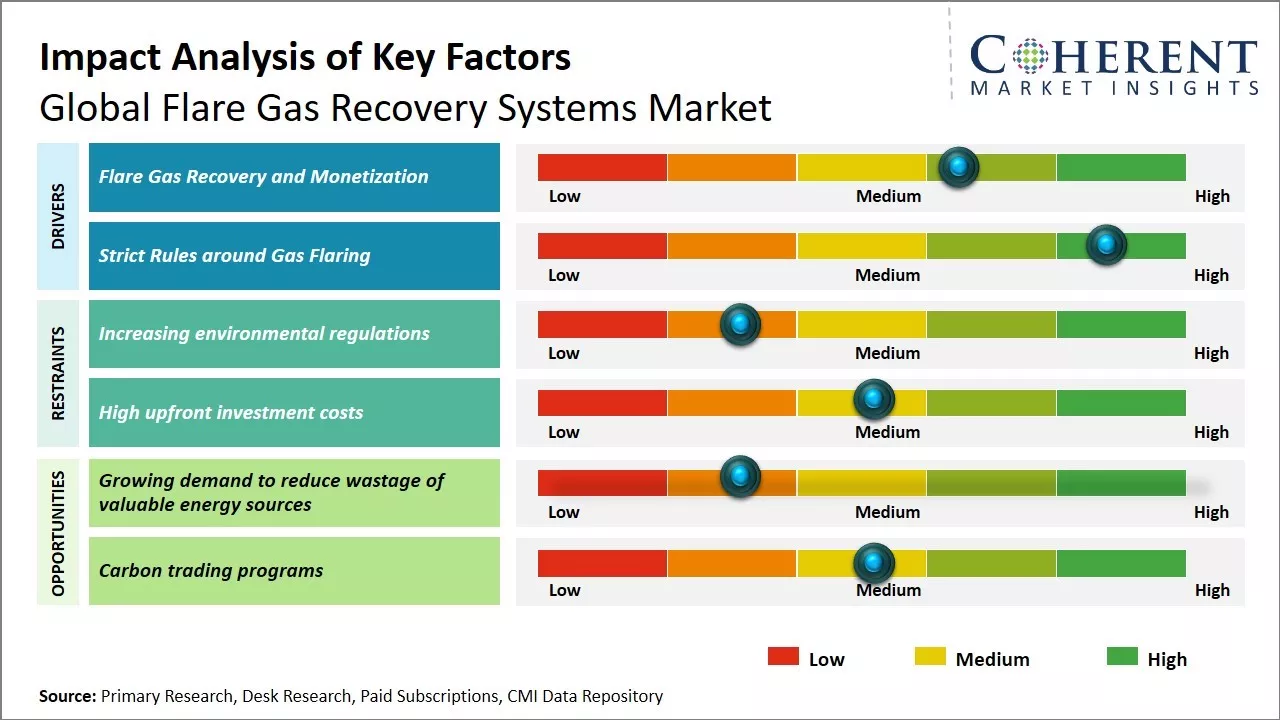
Discover market dynamics shaping the industry: Download Free Sample
Flare gas recovery systems prevent the flaring of hydrocarbon gases and capture them for energy recovery or productive use. These systems aid in reducing environmental pollution and help organizations meet emission reduction targets set by various environmental regulations. The market is driven by stringent government regulations regarding emissions from refineries and oil & gas installations. Major regulations like the United Nations Environment Programme encourage oil producers to minimize flaring by installing flare gas recovery systems. Growing demand from upstream oil & gas and petroleum refining industries will also provide opportunities in the coming years. However, high initial investment costs may hinder the market growth to some extent over the forecast period.
Flare Gas Recovery and Monetization
Flare gas recovery and monetization is a major factor driving the growth of the global flare gas recovery systems market. With flare gas containing significant amounts of valuable natural gas compounds like methane and ethane, many oil and gas companies are now looking to capture this wasted gas and convert it into a profitable revenue stream. As per data from the World Bank, annual flaring of natural gas currently results in over USD 20 billion worth of lost natural gas worldwide. This loss of revenue coupled with increasing concerns over greenhouse gas emissions from flaring has prompted stricter regulations around the world. For example, countries like Russia and Nigeria have imposed penalties on routine gas flaring at oil production sites to promote gas utilization and monetization over the past few years. This push for recovery and monetization of flared gas is creating significant demand for flare gas recovery systems across onshore and offshore oil production facilities. Many oil producers are proactively investing in advanced flare gas recovery units to extract value from flared methane efficiently. These units not only help eliminate routine gas flaring but also generate additional revenue through sale of recovered gas. Some companies have also integrated processes to convert extracted gas into useful byproducts like liquefied petroleum gas (LPG) that command stable market value. The rising focus on environmental compliance and revenue optimization from associated gas production is likely to ensure continued growth prospects for the flare gas recovery systems market over the coming years according to several industry reports and statements by the United Nations Environment Program (UNEP). The pursuit of gas flaring elimination combined with monetization opportunities for captured methane will remain key drivers propelling the global market forward.
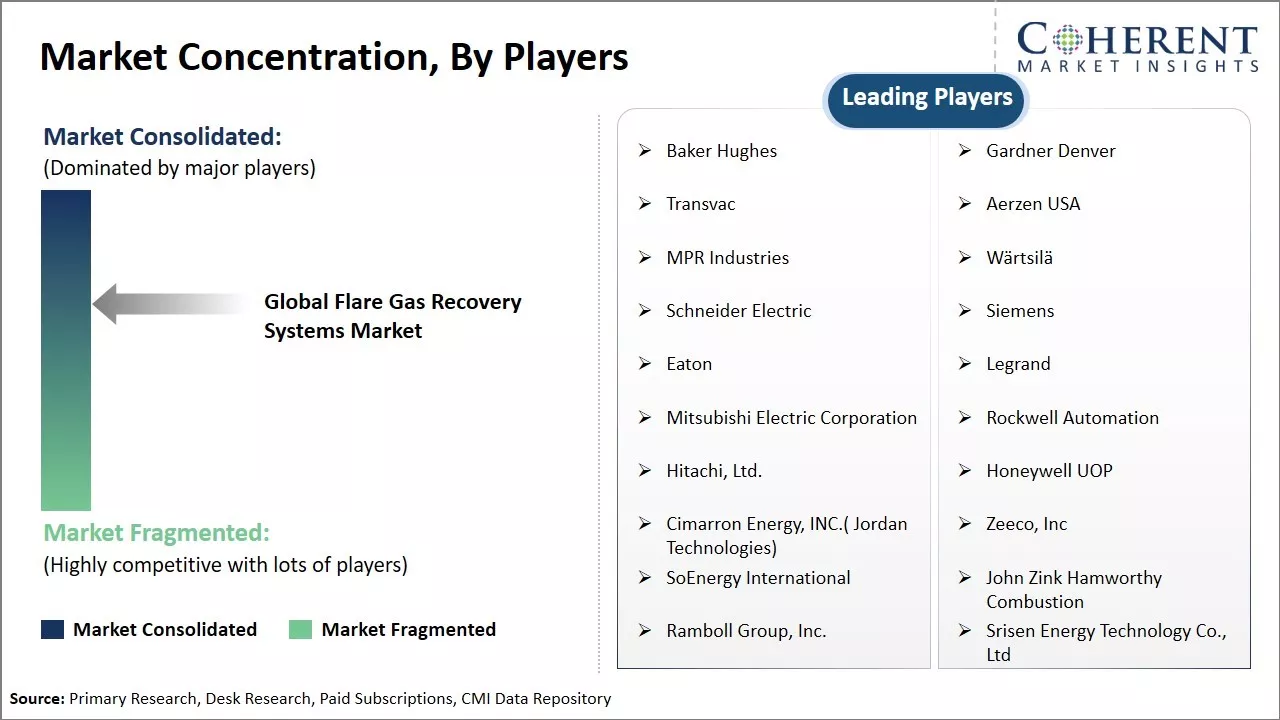
Get actionable strategies to beat competition: Download Free Sample
Strict Rules around Gas FlaringMany governments and regional authorities view gas flaring as an environmental hazard and are placing stricter rules around allowing and monitoring such activities. Major oil producing regions like the Middle East and Africa which contribute hugely to global flaring volumes have come under scrutiny. Local communities are also raising their voice against regular sighting of flames at oilfields. While occasional technical flaring cannot be avoided, continuous flaring over long periods is being treated as a non-compliant activity. Authorities are enacting zero routine flaring by 2030 targets and monitoring emission numbers closely. Fines and penalties for excessive or unapproved flaring have also been increased. To stay compliant and avoid costly disciplinary actions, upstream players have little choice but to curb regular flaring drastically which can only be done by installing gas recovery and processing facilities. Thus, tighter emission norms are a driver to boost deployments of flare gas recovery systems.
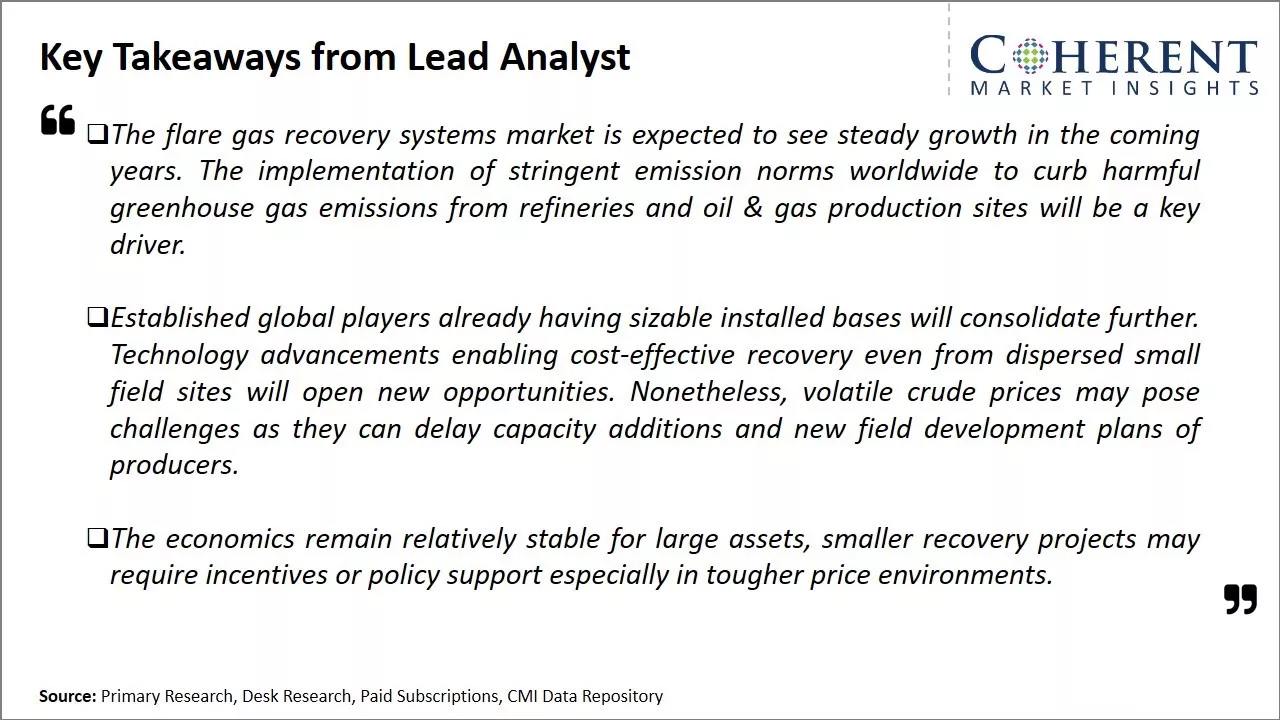
To learn more about this report, Download Free Sample
Challenges: Increasing environmental regulationsOne of the major challenges faced by the flare gas recovery systems market is increasing environmental regulations regarding greenhouse gas emissions. As governments globally implement stricter norms on flaring of associated gas at production sites, oil and gas companies need to invest heavily in recovery technologies. Additional challenges include high initial capital investment required for setup and maintenance of flare gas recovery infrastructure.
Opportunities: Growing demand to reduce the wastage of valuable energy sources
However, the market sees significant opportunities from growing demand to reduce wastage of valuable energy sources. Recovering flare gas enables producers to utilize it for on-site power generation or gas transportation via pipelines. Stringent rules providing incentives for gas utilization over controlled burning of flare also encourages the adoption of these systems. Investments in recovery can help companies lower operating costs through gas reuse.
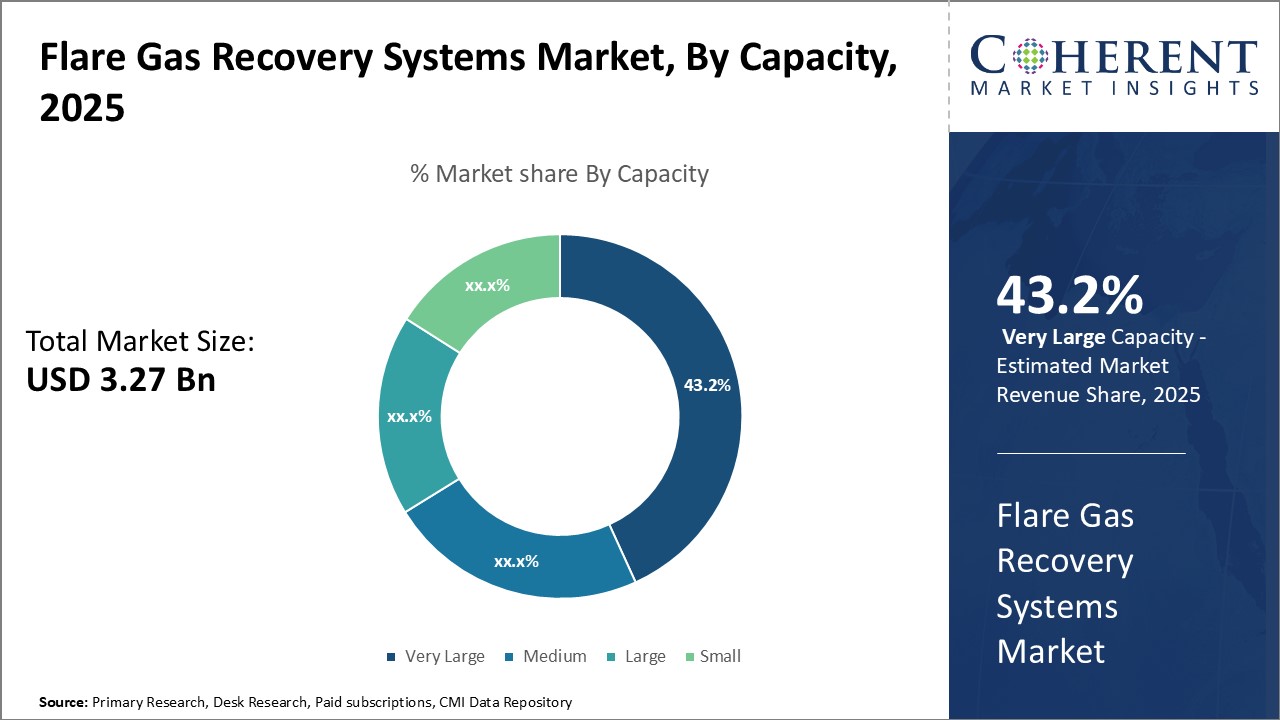
Discover high revenue pocket segments and roadmap to it: Download Free Sample
Insights By Capacity: Economies of Scale Drive the Demand for Very Large Capacity SystemsWithin the flare gas recovery systems market segmented by capacity, the very large segment is expected to contribute 43.2% share in 2025. This is largely due to economies of scale that make very large systems highly appealing for major industrial facilities producing massive volumes of flare gas on a continual basis. Very large flare gas recovery systems, with processing capacities of 50 million standard cubic feet per day or more, are predominantly installed at sprawling petroleum refineries, large chemical plants, and major natural gas treatment facilities. The flare gas streams generated by these gargantuan industrial operations are simply too voluminous for anything smaller than a very large system to effectively capture and process. It would not be economically feasible to install and operate multiple smaller or mid-sized systems across such expansive facilities. By consolidating flare gas handling into a single mega-sized recovery unit, capital costs per standard cubic foot of processing capability are dramatically reduced. Maintenance is also more streamlined as there is only one integrated system rather than several. Very large designs additionally allow for economies of scale in components such as blowers, compressors, separators, and flaring equipment, lowering the overall cost per unit of throughput. As environmental regulations continue tightening restrictions on flaring, major industrial plants are under increasing pressure to rein in emissions. A very large flare gas recovery system provides the muscle needed to capture and utilize the tremendous volumes of gas produced at these massive facilities, helping optimize compliance cost-effectively. For refineries, petrochemical complexes and other such gargantuan industrial operations, a very large capacity system is essentially indispensable.
Insights By Application: FPSO Platforms: Driving Demand through Remote Operations
Within the application segment of the flare gas recovery systems market, floating production, storage and offloading (FPSO) platforms is expected to contribute 36.2% of the market share in 2025. This stems from the unique operational challenges associated with utilizing recovered flare gas offshore. Situated far out at sea, FPSO platforms produce vast amounts of associated gas along with crude oil extracted from remote underwater reservoirs. Without access to pipelines, much of this associated gas was traditionally flared directly into the atmosphere. However, as environmental regulations have tightened, flaring from offshore oil and gas development has likewise faced increasing restrictions. To reduce waste while maintaining the production uptime, FPSO operators now rely heavily on flare gas recovery systems. Rather than simple flaring, these capture associated gas and prepare it to be reinjected, used as fuel on the platform, or converted into LNG for transport. Given the difficulty and expense of performing maintenance offshore, FPSO systems are engineered for maximum uptime remotely via condition monitoring. Modular, skid-mounted flare gas recovery packages are also well-suited to FPSO applications, as they can be pre-built, tested and transported intact for quick, plug-and-play installation. With operators under pressure to eliminate routine flaring from remote offshore sites, demand is strong for dedicated FPSO systems offering maximum uptime through robust remote operation capabilities.
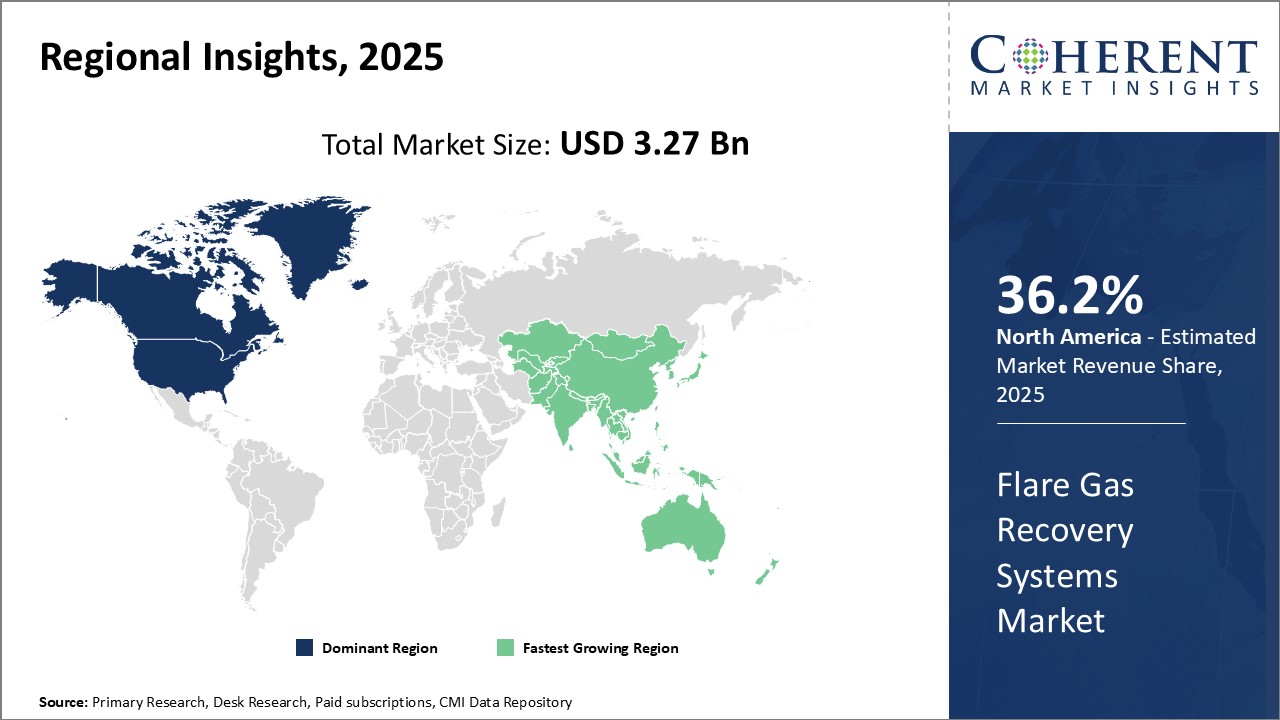
Need a Different Region or Segment? Download Free Sample
North America has emerged as the dominant regional market for flare gas recovery systems. The region accounts for over 36.2% of the global demand due to the large concentration of oil & gas assets and stringent regulatory measures to curb flaring activities. Countries like the U.S. and Canada have old oilfields with substantial associated gas production, necessitating effective gas handling processes to meet environmental mandates. The presence of major flare gas recovery system providers, such as Zeeco, John Zink Hamworthy Combustion, and UOP, has further strengthened the regional supply chain to cater to the growing infrastructure needs. The flourishing shale gas industry, characterized by associated gas flaring, has spurred new installations of zero-flare combustors and vapor recovery units across several midstream facilities in the U.S. States like Texas and North Dakota have spearheaded flare elimination plans in collaboration with oil producers to recover more saleable hydrocarbon volumes. Meanwhile, new pipeline projects connecting remote production zones to gas networks have augmented the utilization of recovered flare gas. Growing precedence of utilizing recovered gases as an indigenous fuel source has also opened opportunities for flare gas-to-power projects.
Asia Pacific, on the other hand, has emerged as the fastest growing regional market for flare gas recovery systems. Countries like India, Indonesia, Malaysia, and Thailand are witnessing substantial capital expenditures in developing offshore assets and expanding refinery infrastructure. Local governments have rolled out time-bound flare-out commitments in line with international protocols, necessitating the adoption of advanced gas conservation systems. Indian public sector majors have initiated brownfield modernization programs, encompassing flare gas handling upgrades at several mature fields and refineries. Meanwhile, new LNG exporting facilities coming online in Indonesia, Australia, and Malaysia have installed state-of-the-art consoles to eliminate routine flaring and maximize fuel gas usage.
Flare Gas Recovery Systems Market Report Coverage
| Report Coverage | Details | ||
|---|---|---|---|
| Base Year: | 2024 | Market Size in 2025: | USD 3.27 Bn |
| Historical Data for: | 2020 To 2024 | Forecast Period: | 2025 To 2032 |
| Forecast Period 2025 to 2032 CAGR: | 10.0% | 2032 Value Projection: | USD 6.37 Bn |
| Geographies covered: |
|
||
| Segments covered: |
|
||
| Companies covered: |
Baker Hughes , Gardner Denver , Transvac , Aerzen USA, MPR Industries, Wärtsilä , Schneider Electric, Siemens, Eaton, Legrand, Mitsubishi Electric Corporation, Rockwell Automation, Hitachi, Ltd., Honeywell UOP, Cimarron Energy, INC.( Jordan Technologies), Zeeco, Inc, SoEnergy International, John Zink Hamworthy Combustion, Ramboll Group, Inc., and Srisen Energy Technology Co., Ltd |
||
| Growth Drivers: |
|
||
| Restraints & Challenges: |
|
||
Uncover macros and micros vetted on 75+ parameters: Get instant access to report
*Definition: Flare gas recovery systems market refers to the solutions and equipment designed to recover gases from industrial flaring processes. Flare gas recovery systems aim to capture hydrocarbon gases from refineries, gas processing plants, and other industrial facilities that would otherwise be burned or released into the atmosphere during flaring operations. These systems separate and process flare gases to recover usable byproducts like methane, ethane, and propane while also reducing air pollution and waste of valuable resources during emergency venting and startup/shutdown procedures.
Share
Share
About Author
Yash Doshi is a Senior Management Consultant. He has 12+ years of experience in conducting research and handling consulting projects across verticals in APAC, EMEA, and the Americas.
He brings strong acumen in helping chemical companies navigate complex challenges and identify growth opportunities. He has deep expertise across the chemicals value chain, including commodity, specialty and fine chemicals, plastics and polymers, and petrochemicals. Yash is a sought-after speaker at industry conferences and contributes to various publications on topics related commodity, specialty and fine chemicals, plastics and polymers, and petrochemicals.
Missing comfort of reading report in your local language? Find your preferred language :
Transform your Strategy with Exclusive Trending Reports :
Frequently Asked Questions
Joining thousands of companies around the world committed to making the Excellent Business Solutions.
View All Our Clients